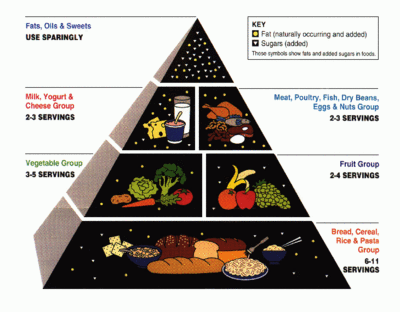Food guide pyramid
|
|
The food guiding pyramid, informally known as the food pyramid, was a nutrition guide created by the USDA. Released in 1992, it suggested how much of each food category one should eat each day. The food guide pyramid replaced the four food groups. On April 19, 2005, the USDA released the food guide pyramid's successor, MyPyramid.
In general terms the food guide pyramid recommends the following intake of different food groups each day, although exact amounts of calorie intake depends on sex, age, and lifestyle:
- 3-5 servings a day of vegetables, especially green, leafy vegetables;
- 2-3 servings of fruits a day;
- sparing use of fats, oils and sweets or can be 2-4 times in two months.
| Contents |
Explanation of nutritional values
- The largest, bottom layer (grains) provides mainly energy (calories) in the form of complex carbohydrates. It may also contribute significant quantities of vitamins and fiber, especially if whole grains are used.
- The second layer (fruit and vegetables) contains food that are high in vitamins and fiber, also providing some energy.
- The third layer (animal products, nuts and beans) contains high-protein foods. They also provide energy and some vitamins. Dairy products are high in calcium. Nuts and beans are high in fiber, but nuts also have a high fat content.
- The top of the pyramid (sweets, fats and oils, to be used sparingly) contains foods that are very high in energy (fats and oils) or release their energy very quickly (sweets). This foods needs to be eaten once or twice, or as said - sparingly.
Criticism
The worldwide problem of obesity is increasing in the developed world as well as in developing countries. Therefore it is thought that there must be a fundamental flaw in the guidance as implemented by public agencies such as schools, etc.
It is alleged that the research leading to the construction of the food guide pyramid was (http://www.hateweight.com/food_guide_pyramid.html) partially funded by the meat, dairy, sugar and grain industries, or that the pyramid reflects lobbying by these industries. It is worth noting that the USDA is responsible for promoting agricultural commerce, rather than the health of American citizens. This has led to a number of allegations:
- Some feel that this biased the research towards including higher amounts of meat and dairy produce in the food pyramid than are actually healthy, and that modern nutritional research suggests that the amounts of meat and dairy produce suggested is too high. This has caused some nutritionists to suggest following a vegan diet, or at least a diet with reduced quantities of meat and dairy produce.
- Others feel that high-glycemic carbohydrate foods such as potatoes, pasta and grains receive too much emphasis. These foods are placed in the largest box in the pyramid.
- Many people claim that sweets and most oils and fats are entirely unnecessary and have no place in the pyramid. At that same time, some oils are now seen as essential parts of the diet, but the difference is not reflected in the pyramid (see essential fatty acid).
A new Food Guide Pyramid, MyPyramid, was released in 2005 to reflect the increase in knowledge since 1992.
See also
- Healthful eating
- Healthy eating pyramid, an alternative guide
- MyPyramid, the successor to the food guide pyramid
External links
- The USDA Food Guide Pyramid (http://www.usda.gov/cnpp/pyramid.html) at the USDA Center for Nutrition Policy and Promotion
- MyPyramid U.S. government website (http://www.mypyramid.gov/pyramid/index.html)
- The Food Guide Pyramid (pamphlet) (http://www.pueblo.gsa.gov/cic_text/food/food-pyramid/main.htm) The USDA's Center for Nutrition Policy and Promotion, 1996
- Food Pyramids (http://www.hsph.harvard.edu/nutritionsource/pyramids.html) Harvard School of Public Health Nutrition Source, Shows the difference of the Healthy Eating Pyramid from the USDA pyramid.
- Rebuilding the Food Pyramid (http://www.sciam.com/article.cfm?articleID=0007C5B6-7152-1DF6-9733809EC588EEDF&pageNumber=1&catID=2) Scientific American, Jan 2003.
- Is the Food Pyramid Obsolete? (http://www.npr.org/display_pages/features/feature_851835.html) npr.org, Nov 21 2002.
- The Way We Eat Now (http://www.harvard-magazine.com/on-line/050465.html) harvard-magazine.com, May-June 2004.
- Two healthy alternatives – the Mediterranean and the Asian Diet Pyramids (http://www.mediterrasian.com/meda_living.htm)
- Vegan Food Pyramid (http://www.choosevegetarian.com/vegan_food_pyramid.asp)
- Criticism of the Food Pyramid in the Wall Street Journal , 2002 (http://www.karlloren.com/diet/p109.htm)

